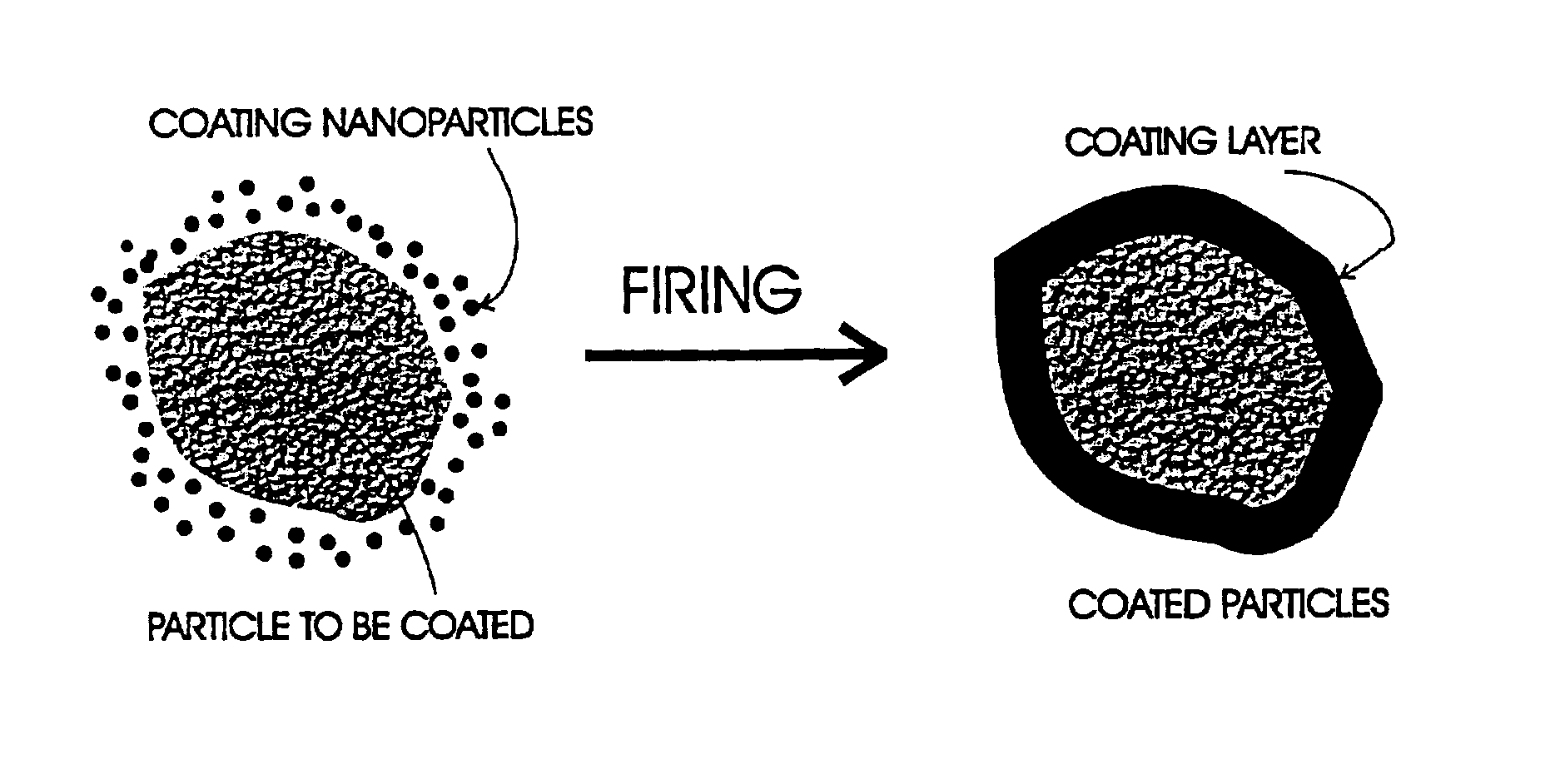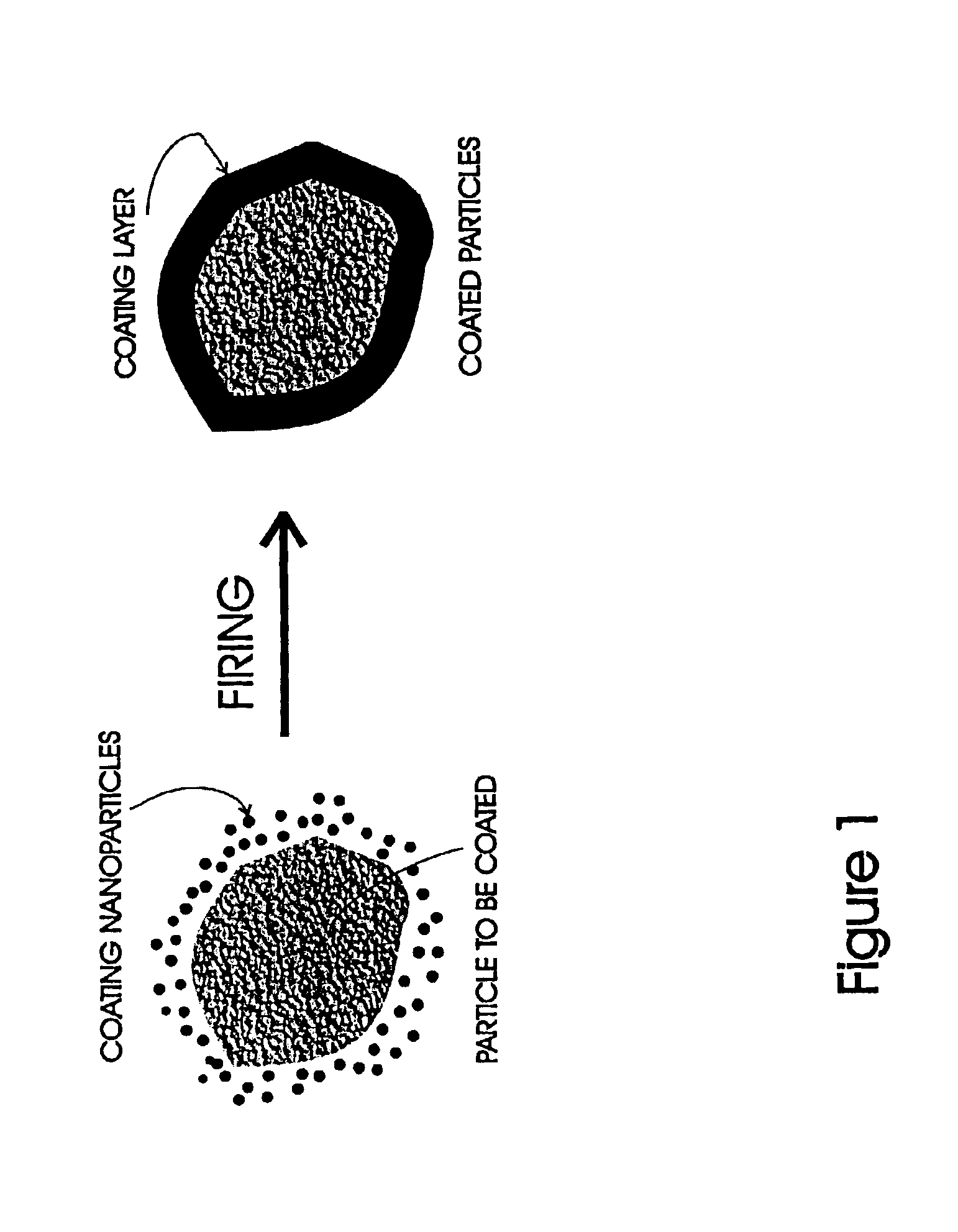Method of coating micrometer sized inorganic particles
a technology of inorganic particles and coatings, applied in the direction of mechanical vibration separation, material granulation, coatings, etc., can solve the problem of insufficient temperature to change the surface properties of the larger inorganic particles to be coated
- Summary
- Abstract
- Description
- Claims
- Application Information
AI Technical Summary
Benefits of technology
Problems solved by technology
Method used
Image
Examples
example 1
[0024]Fifty grams of dry SrS:Eu:Er:Dy phosphor powder that emits orange light for a few tens of minutes when excited with ultraviolet or visible light, and that has a particle size of from about 1 to about 100 micrometers, were blended with five grams of fumed silica particles having an average particle size of about 7 nanometers. Fumed silica particles having a particle size of about 2-3 to 50 nanometers are commercially available as Aerosil 30® from the DeGussa Corporation. They have a softening point of about 800° C.
[0025]The phosphor and silica particles were placed in a 200 ml cap sealed container and blended together for 30 minutes using a motor driven blender (TURBULA, a tradename of Glen Mills, Inc. of New Jersey) with the assistance of cylindrical ceramic milling balls about ½ inch by ½ inch, also placed in the container. The ceramic milling balls prevent agglomeration of the powders and particles and are readily removed from the coated inorganic particles using an appropri...
example 2
[0033]A fifty gram sample of a moisture sensitive long persistence red phosphor, CaS:Eu+2Tm+3, commercially available as “LUMILUX®” from Allied Signal, Inc, and 3 grams of Aerosil 30® were blended as in Example 1 in a 200 ml cap sealed container. This phosphor has a pink body color and emits red light for a few tens of minutes after being excited with UV / Visible light.
[0034]The blended particles were fired for 40 minutes in a tube-type furnace at 800° C. under a nitrogen purge gas. After firing, the phosphor was found to have shrunk in volume, but no sintering was visible. The body color remained unchanged. The coated phosphor was washed with water, followed by drying at room temperature in air overnight.
[0035]The dried sample was tested by immersing in water for two months. After this test, the body color remained pink and the nature of the emission was unchanged.
[0036]An un-coated control sample of the same phosphor was also immersed in water. The body color turned pinkish-red and...
example 3
[0037]The method of Example 2 was repeated using three silica particle sizes; Aerosil® 150; Aerosil® 200 and Aerosil® 300, having particle sizes of 150, 200 and 200 nm respectevely.
[0038]Water impervious coatings were obtained for the phosphor particles for all nanometer silica particle sizes.
PUM
| Property | Measurement | Unit |
|---|---|---|
| particle size | aaaaa | aaaaa |
| particle size | aaaaa | aaaaa |
| particle size | aaaaa | aaaaa |
Abstract
Description
Claims
Application Information
 Login to View More
Login to View More - R&D
- Intellectual Property
- Life Sciences
- Materials
- Tech Scout
- Unparalleled Data Quality
- Higher Quality Content
- 60% Fewer Hallucinations
Browse by: Latest US Patents, China's latest patents, Technical Efficacy Thesaurus, Application Domain, Technology Topic, Popular Technical Reports.
© 2025 PatSnap. All rights reserved.Legal|Privacy policy|Modern Slavery Act Transparency Statement|Sitemap|About US| Contact US: help@patsnap.com


